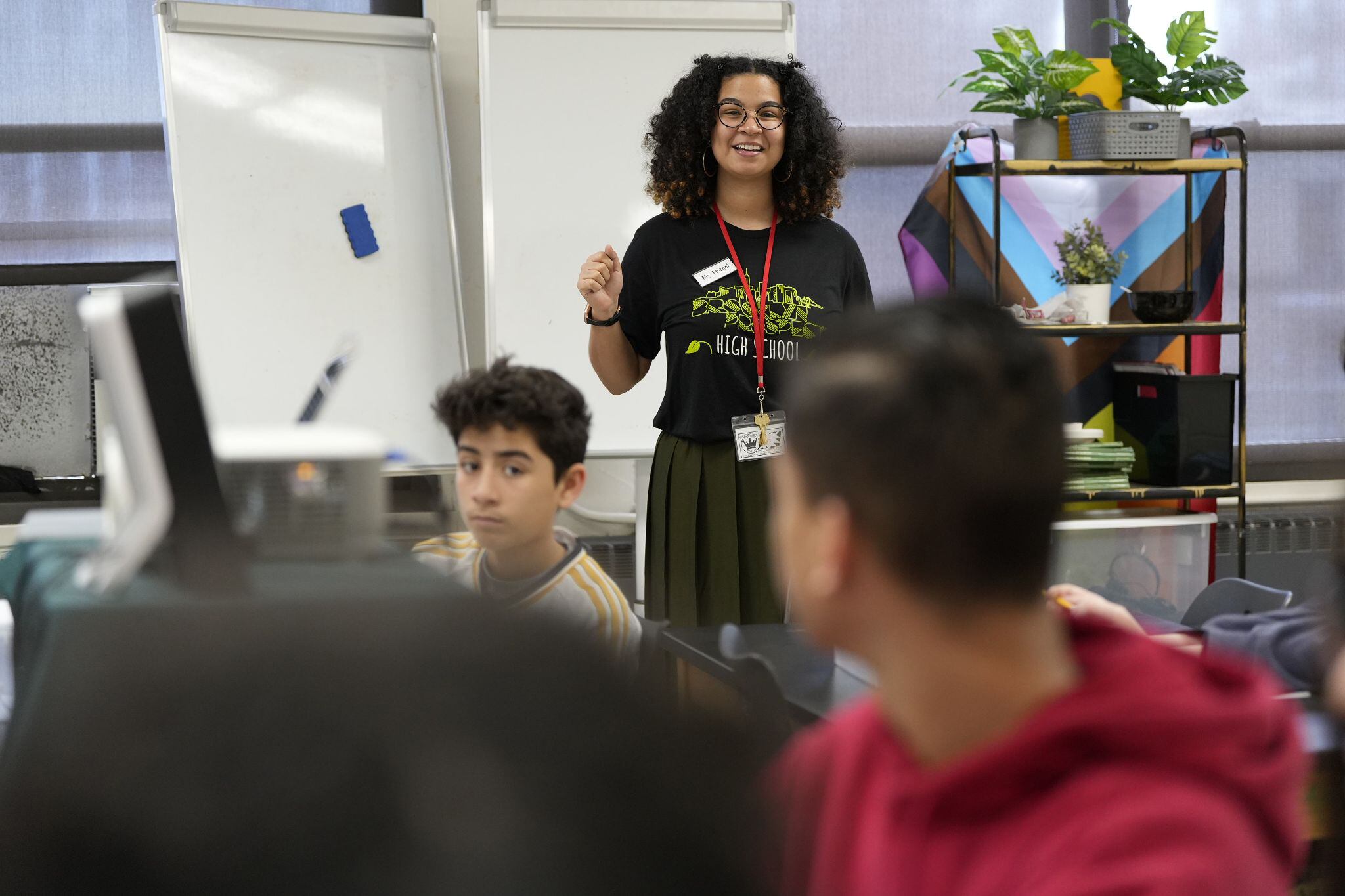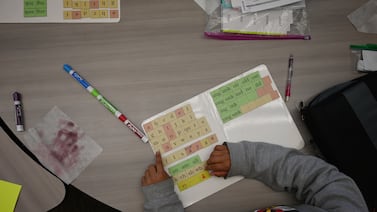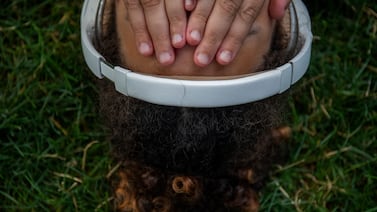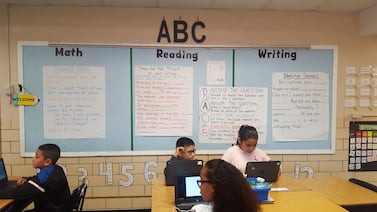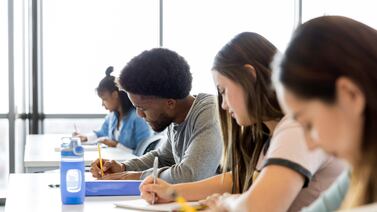It might seem odd that a high school psychology teacher would be selected for a National Geographic teacher fellowship in the Arctic, but for Caitlyn Homol, last summer’s “paradigm-shifting experience” inspired her to develop a new interdisciplinary unit.
As the International Baccalaureate, or IB, Teaching and Learning Coordinator and IB Psychology teacher at Brooklyn Prospect High School, Homol is teaming up with her school’s Environmental Systems and Societies course to explore “the relationship between motivation, action, and climate attitudes that culminates in a beach cleanup and reflection.”
While on the 17-day expedition, Homol saw polar bears on land since there wasn’t enough sheet ice for their traditional hunting patterns. She saw marine debris on the shores of islands hundreds of miles north of inhabited towns. She and others started to feel pessimistic “about our collective chances of being able to preserve the sights we were seeing for future generations.”
That led Homol to get involved with visiting scientists from the Rozalia Project as they collected data on microplastics in the waters. She ended up filling in at the last minute for one of Rozalia’s Maine expeditions right as school was starting, helping them meet their 20,000-pound cleanup goal for summer 2023. That experience, she said, “brought me so much hope and energy for what we can do when we work together to do hard things.”
Homol, who has spent four of her nine-year teaching career at Brooklyn Prospect, recently won a national teaching award from the American Psychological Association.
Teaching psychology, Homol believes, gives students a strong background in social science research, and she encourages her students to seek out research opportunities when they go to college.
“I also think this course has so many natural connections with students’ own experiences,” she said. “There’s a unique chance for them to develop new self-knowledge while also expanding their perspectives of other people’s experiences.”
This interview has been lightly edited for length and clarity.
How and when did you decide to become a teacher?
I attended Ohio State University as a first-generation student who had also been very transient in middle and high school, bouncing between schools up and down the East Coast and the South. I’d been a successful student but missed more than a couple of foundational courses I needed to be successful in my initial declared major, which was biomedical engineering. I was confused and humiliated by the struggles I faced in my chemistry and calculus classes, and after ending up on academic probation my first quarter, I lied to most people about how school was going because I was terrified of letting them down.
As a condition of exiting probation, I chose to take an education psychology course about study strategies at the Dennis Learning Center. It was transformative and helped reduce the fear I felt that I did not belong in college. I ended up working there for three years of undergrad as a learning specialist, where I facilitated workshops and met 1:1 with other students at OSU to interpret research to find meaningful study strategies.
That’s what led me to consider teaching, and Teach for America was an alternative certification program I was familiar with.
What’s your favorite lesson to teach and why?
I deeply appreciate my colleague, Khanh Le, who adapted an exercise she came across in her developmental psych program for our students. It asks students to take a fictional family of seven of different genders and ages and arrange them into hypothetical homes with room counts ranging from 1-7, in arrangements that are both ideal and least ideal.
Our students, who have a variety of cultural backgrounds, are often surprised to find that they have nearly unanimous agreement with each other in their room arrangements. We discuss the findings of the original study, which suggest that some values driving those arrangements are unique to the West and others are universal — and the consensus we have in our own answers is a proof of acculturation, or assimilation to U.S./New York culture. I love this lesson because it ties together research, relatability, and strikes a balance between appreciating difference and finding commonality with others around the world.
Are there particular things that students are seeing or experiencing in their lives related to the course that come up in the classroom?
The first thing that has positively shifted the tone of conversations we have in class is the decreasing stigma of mental health concerns.
At our school, we teach the “Abnormal Psychology” option offered in the IB Psychology course, and students are tremendously open and excited to share their experiences with each other. I would have been so embarrassed to talk about my mental health at that age, but kids are supportive and continue the conversation with questions or their own contributions.
The second development I’ve seen is less positive: I’ve noticed that students carry more pessimism these days. More students feel that nothing matters, and that there is nothing that can be done to improve the circumstances of themselves or their communities. This is a comprehensible reaction to climate developments, the inertia of systems and institutions to change, and an eroding pretense that a college education is a ticket to financial stability. I also think social media algorithms proliferate a lot of cynical (if not outright incorrect) interpretations of psychological and sociological knowledge.
I think as educators of young people, part of our role is to inspire students and to teach pathways to change. Of course, we have a duty to portray the world realistically in our classrooms. Many things are actually dire. But I think we also must take care to invite students to construct generative interpretations and applications of knowledge and research. Otherwise, we are left with the status quo and that pessimistic vision does become our fate.
We also have to let them feel the impact of taking action with others, *doing* things rather than just talking about them. This is tricky for adults too, but my summer experiences underscored how meaningful optimism comes from collective work and creation.
Tell us about your own experience with school and how it affects your work today.
I was incredibly blessed to have consistently caring, effective, and diverse teachers for all 13 years of my public schooling. I especially credit the many Black women who taught me at Arlington Elementary School in Jacksonville, Fla., who saw my potential and imparted to me a sense of duty to make the most of my education.
It has been easy to draw from the example they and my other amazing educators set as I show up for students today. But the thing that has most shaped my overall career trajectory has been the challenges I faced as a student who wanted access to specialized programming.
I happened to find out about the International Baccalaureate program in my district through idle conversation with my school librarian, rather than through my school counselor or district-wide advertisement. I had to submit an application, attend an interview or take a test, and take a bus an hour each way to get to school. Years later, I found myself in rural Alabama: I navigated several hurdles to take online AP classes that were made available upon request through Alabama’s ACCESS plan for distance learning. There were so many hurdles to being able to participate in both programs, and because of it, I have chosen to work at schools that give a broader range of students access to the IB program by default.
What’s the best advice you’ve ever received, and how have you put it into practice?
A mentor once told me, “Let someone else tell you no,” when I was debating sending in an application for a job opportunity years ago. For scholarships, school program ideas, jobs, or awards, spending less time being my own gatekeeper has opened up fantastic experiences.
Most recently, I pitched an ambitious idea to the Rozalia Project, which included setting aside spots on a July expedition on their sailboat for a teacher and a recent high school graduate — she said yes! Making this initial ask has also let us start envisioning a recurring beach cleanup program and a full Prospect Schools expedition a couple years out from now. We have other details to work out, but if I had let my own ‘no’ get in the way, I would have never fathomed how excited they would be to develop this partnership.
Amy Zimmer is the bureau chief for Chalkbeat New York. Contact Amy at azimmer@chalkbeat.org.


